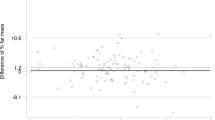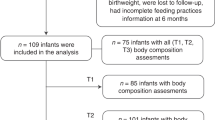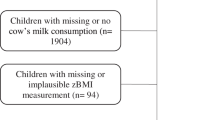Abstract
Background/Objectives:
The fatty acid composition in maternal diet and in breastmilk during lactation may be a factor in the development of childhood overweight later in life. To investigate the association between trans fatty acid and adiposity, 96 mother–infant pairs (exclusive breastfed; mixed fed; and formula fed) at 3 months postpartum were interviewed; body composition was measured onsite using the BOD POD and PEA POD for mothers and infants, respectively.
Subjects/Methods:
This was a cross-sectional study. Participants were recruited via convenience sampling from Athens-Clarke and surrounding counties of the state of Georgia. Data were analyzed using χ2, analysis of variance and regression.
Results:
There were no significant differences in maternal percent body fat by feeding group (32.70, 33.70, and 35.73%, for exclusive, mixed and formula feeding, respectively). Exclusively breastfed infants had higher percent body fat (24.87%) compared with their mixed-fed counterparts (22.15%) but not formula-fed infants (23.93). Mothers who consumed at least 4.5 g of trans fatty acids/day were 5.8 times more likely to have body fat ⩾30% than those consuming less (odds ratio=5.81; 95% confidence interval (CI), 1.05, 32.32), and their infants were over two times more likely (odds ratio=2.13; 95% CI, 0.75, 6.01) to have body fat ⩾24%.
Conclusions:
Trans fatty acid content of the maternal diet may be associated with both maternal and infant body composition in the early postpartum period. More research is warranted regarding maternal dietary and breastmilk fatty acid composition and their effects on maternal and infant body composition and the development of childhood overweight later in life.
This is a preview of subscription content, access via your institution
Access options
Subscribe to this journal
Receive 12 print issues and online access
$259.00 per year
only $21.58 per issue
Buy this article
- Purchase on Springer Link
- Instant access to full article PDF
Prices may be subject to local taxes which are calculated during checkout

Similar content being viewed by others
References
Aihaud G, Guesnet P (2004). Fatty acid composition of fats is an early determinant of childhood obesity: a short review and an opinion. Obes Rev 5, 21–26.
Aihaud G, Massiera F, Weill P, Legrand P, Alessandri JM, Guesnet P (2006). Temporal changes in dietary fats: role of n-6 polyunsaturated fatty acids in excessive adipose tissue development and relationship to obesity. Prog Lipid Res 45, 203–236.
American Academy of Pediatrics (2005). Breastfeeding and the use of human milk. Pediatrics 115, 496–506.
American Heart Association Nutrition Committee (2006). Diet and lifestyle recommendations revision 2006. Circulation 114, 82–96.
Anderson NK, Beerman KA, McGuire MA, Dasgupta N, Griinari JM, Williams J et al. (2005). Dietary fat type influences total milk fat content in lean women. J Nutr 135, 416–421.
Bahrami G, Rahimi Z (2005). Fatty acid composition of human milk in Western Iran. Eur J Clin Nutr 59, 494–497.
Blankson H, Stakkestad JA, Fagertun H, Thom E, Wadstein J, Gudmundsen O (2000). Conjugated linoleic acid reduces body fat mass in overweight and obese humans. J Nutr 130, 2943–2948.
Bogen DL, Hanusa BH, Whitaker RC (2004). The effect of breast-feeding with and without formula use on the risk of obesity at 4 years of age. Obesity 12, 1527–1535.
Brewer MM, Bates MR, Vannoy LP (1989). Postpartum changes in maternal weight and body fat depots in lactating vs nonlactating women. Am J Clin Nutr 49, 259–265.
Butte NF, Wong WW, Hopkinson JM, Smith EOB, Ellis KJ (2000). Infant feeding mode affects early growth and body composition. Pediatrics 106, 1355–1366.
Butte NF, Hopkinson JM (1998). Body composition changes during lactation are highly variable among women. J Nutr 128, 381S–381S.
Craig-Schmidt MC (2001). Isomeric fatty acids: evaluating status and implications for maternal and child health. Lipids 36, 997–1006.
Dewey KG, Heinig MJ, Nommsen LA (1993). Maternal weight-loss patterns during prolong lactation. Am J Clin Nutr 58, 162–166.
Fontaine KR, Redden DT, Wang C, Westfall AO, Allison DB (2003). Years of life lost due to obesity. J Am Med Assoc 289, 187–193.
Francois CA, Connor SL, Wander RC, Connor WE (1998). Acute effects of dietary fatty acids on the fatty acids of human milk. Am J Clin Nutr 67, 301–308.
Gaullier JM, Halse J, Hoivik HO, Hoye K, Syvertsen C, Nurminiemi M et al. (2007). Six months supplementation with conjugated linoleic acid induces regional-specific fat mass decreases in overweight and obese. Br J Nutr 97, 550–560.
Gaullier JM, Halse J, Hoye K, Kristiansen K, Fagertun H, Vik H et al. (2004). Conjugated linoleic acid supplementation for 1 y reduces body fat mass in healthy overweight humans. Am J Clin Nutr 79, 1118–1125.
Gaullier JM, Halse J, Hoye K, Kristiansen K, Fagertun H, Vik H et al. (2005). Supplementation with conjugated linoleic acid for 24 months is well tolerated by and reduces body fat mass in healthy overweight humans. J Nutr 135, 778–784.
Grummer-Strawn LM, Mei Z (2004). Does breastfeeding protect against pediatric overweight? Analysis of longitudinal data from the centers for disease control and prevention pediatric nutrition surveillance system. Pediatrics 113, e81–e86.
Gunderson EP, Abrams B, Selvin S (2000a). The relative importance of gestational weight gain and maternal characteristics associated with the risk of becoming overweight after pregnancy. Int J Obes Relat Metab Disord 24, 1660.
Gunderson EP, Abrams B, Selvin S (2000b). The relative importance of gestational gain and maternal characteristics associated with the risk of becoming overweight after pregnancy. Int J Obes Relat Metab Disord 24, 1660.
Institute of Medicine (2009). Weight Gain During Pregnancy: Reexamining the Guidelines. Institute of Medicine: Washington DC.
Kac G, Benicio MHDA, Velasquez-Melendez G, Valente JG, Struchiner CJ (2004a). Gestational weight gain and prepregnancy weight influence postpartum weight retentions in a cohort of Brazilian women. J Nutr 134, 661–666.
Kac G, Benicio MHDA, Velasquez-Melendez G, Valente JG, Struchiner CJ (2004b). Gestational weight gain and prepregnancy weight influence postpartum weight retention in a cohort of brazilian women. J Nutr 134, 661–666.
Kamphuis MM, Lejeune MP, Saris WH, Westerterp-Plantenga MS (2003). The effect of conjugated linoleic acid supplementation after weight loss on body weight regain, body composition, and resting metabolic rate in overweight subjects. Int J Obes Relat Metab Disord 27, 840–847.
Koletzko B (1989). Fat content and fatty acid composition of infant formulas. Acta Paediatr Scand 78, 513–521.
Koletzko B, Baker S, Cleghorn G, Neto UF, Gopalan S, Hernell O et al. (2005). Global standard for the composition of infant formula: recommendations of an ESPGHAN Coordinated International Expert Group. J Pediatr Gastroenterol Nutr 41, 584–599.
Koletzko B, Muller J (1990). Cis- and trans-isomeric fatty acids in plama lipids of newborn infants and their mothers. Biol Neonate 57, 172–178.
Koletzko B, Rodriquez-Palmero M (1999). Polyunsaturated fatty acids in human milk and their role in early infant development. J Mammary Gland Biol Neoplasia 4, 269–284.
Li J-J, Huang CJ, Xie D (2008). Anti-obesity effects of conjugated linoleic acid, docosahexaenoic acid, and eicosapentaenoic acid. Mol Nutr Food Res 52, 631–645.
Lichtenstein AH, Kennedy E, Barrier P, Danford D, Ernst ND, Grundy SM et al. (1998). Dietary fat consumption and health. Nutr Rev 56, S3–S19.
Life Measurement, I (1995). BOD POD Body Composition Tracking System. Life Measurement, Inc.: Concord, CA, USA.
Life Measurement, I (2000). PEA POD Infant Body Composition System. Life Measurement, Inc.: Concord, CA, USA.
Malpuech-Brugere C, Verboeket-van de Venne WP, Mensink RP, Arnal MA, Morio B, Brandolini M et al. (2004). Effects of two conjugated linoleic acid isomers on body fat mass in overweight humans. Obes Res 12, 591–598.
Mello MM (2009). New York city's war on fat. N Engl J Med 360, 2015–2020.
Mente A, de Koning L, Shannon HS, Anand SS (2009). A systematic review of the evidence supporting a causal link between dietary factors and coronary heart disease. Arch Intern Med 169, 659–669.
Mougios V, Mataskas A, Petridou A, Ring S, Sagredos A, Melissopoulou A et al. (2001). Effect of supplementation with conjugated linoleic acid on human serum lipids and body fat. J Nutr Biochem 12, 585–594.
Mozzafarian D, Katan MB, Ascherio A, Stampfer MJ, Willet WC (2006). Trans fatty acids and cardiovascular disease. N Engl J Med 354, 1601–1613.
Neville MC, Picciano MF (1997). Regulation of milk lipid secretion and composition. Annu Rev Nutr 17, 159–184.
Ogden CL, Troiano RP, Briefel RR, Kuczmarski RJ, Flegal KM, Johnson CL (1997). Prevalence of overweight among preschool children in the United States, 1971 through 1994. Pediatrics 99, e1–7.
Owen CG, Martin RM, Whincup PH, Davey-Smith G, Gillman MW, Cook DG (2005). The effect of breastfeeding on mean body mass index throughout life: quantitative review of published and unpublished observational evidence. Am J Clin Nutr 82, 1298–1307.
Potter S, Hannum S, McFarlin B, Essex-Sorlie D, Campbell E, Trupin S (1991). Does infant feeding method influence maternal postpartum weight loss. J Am Diet Assoc 91, 441–446.
Sampath H, Ntambi JM (2005). Polyunsaturated fatty acid regulation of genes of lipid metabolism. Annu Rev Nutr 25, 317–324.
Simopoulos AP (2006). Evolutionary aspects of diet, the omega-6/omega-3 ratio and genetic variation: nutritional implications for chronic diseases. Biomed Pharmocother 60, 502–507.
Smedman A, Vessby B (2001). Conjugated linoleic acid supplementation in humans-metabolic effects. Lipids 36, 773–781.
Stettler N, Stallings VA, Troxel AB, Zhao J, Schinnar R, Nelson SE et al. (2005). Weight gain in the first week of life and overweight in adulthood: a cohort study of European American subjects fed infant formula. Circulation 111, 1897–1903.
Sun Q, Ma J, Campos H, Hankinson SE, Manson JE, Stampfer MJ et al. (2007). A prospective study of trans fatty acids in erythrocytes and risk of coronary heart disease. Circulation 115, 1858–1865.
United States Department of Health Human Services. (2005). Breastfeeding-Best for Baby, Best for Mom. USDHHS: Washington DC.
Woodside JV, McKinley MC, Young IS (2008). Saturated and trans fatty acids and coronary heart disease. Curr Atheroscler Rep 10, 460–466.
World Health Organization. (1985). Energy Protein Requirement Report. Joint FAO/WHO/UNU: Geneva, Switzerland.
Acknowledgements
Funding for this project was provided by the University of Georgia Research Foundation (UGARF) through the office of the Vice President for Research. We thank all mother–infant pairs for their participation in this study.
Author information
Authors and Affiliations
Corresponding author
Ethics declarations
Competing interests
The authors declare no conflict of interest.
Rights and permissions
About this article
Cite this article
Anderson, A., McDougald, D. & Steiner-Asiedu, M. Dietary trans fatty acid intake and maternal and infant adiposity. Eur J Clin Nutr 64, 1308–1315 (2010). https://doi.org/10.1038/ejcn.2010.166
Received:
Revised:
Accepted:
Published:
Issue Date:
DOI: https://doi.org/10.1038/ejcn.2010.166
Keywords
This article is cited by
-
Pregnancy eating attributes study (PEAS): a cohort study examining behavioral and environmental influences on diet and weight change in pregnancy and postpartum
BMC Nutrition (2016)
-
Characterization of Cyclooxygenase-2 and its induction pathways in response to high lipid diet-induced inflammation in Larmichthys crocea
Scientific Reports (2016)
-
Antenatal predictors and body composition of large-for-gestational-age newborns: perinatal health outcomes
Journal of Perinatology (2014)



